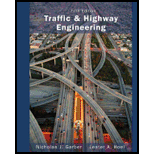
Concept explainers
The five characteristics of visual reception relevant to transportation engineering.
Explanation of Solution
The five characteristics of visual reception relevant to transportation engineering are:
(1) Visual Acuity
(2) Peripheral Vision
(3) Color Vision
(4) Glare Vision and Recovery
(5) Depth Perception
1. Visual Acuity:
Visual Acuity is used to find very small particles of an object which reflects individual sight distance of the person to their line of vision. This is measured in united states using a Snellen eye chart. This is the standard form of a length of an exam room, which is the length in the United States.
2. Peripheral Vision:
Peripheral Vision is the capability of people to see the objects beyond the hollow surface for the clearest vision. When the driver sees a vehicle coming near to his vehicle from the side, it is known as peripheral vision. Although the object may not be clear but using the hollow surface the object can be seen up to an angle depending upon the speed of the vehicle.
3. Color Vision:
Color vision is used to differentiate from one color to another color, but inefficiency to do so is referred to as color blindness. In this color combination test, black and white and black and yellow is tried on a person eyes. These color combinations are sensitive, and are usually used in regulatory traffic signals and in warnings.
4. Glare Vision and Recovery:
Direct and specular are the two types of glare vision.
When directly bright light falls on drivers' eye like a headlight shining in the eyes of the driver than direct glare occurs. When a bright light is reflected by the image in the field of vision example windshield reflected by the sun than specular glare occurs.
When the light source is passed through the effects of glare than the time required for a person for recovery of the effects is called glare recovery.
5. Depth Perception:
It is the ability to estimate distance, speed and to see the object in three-dimensional views. It is used during turning and passing man oeuvres of a two-lane highway.
Want to see more full solutions like this?
Chapter 3 Solutions
Traffic And Highway Engineering
- Text Book Problem 7.82 (page 261) Consider the total head-loss in the system forthis flow is 18.56 ft (head-losses in first and second pipe are 13.83 ft and 4.73 ftrespectively). Please show numerical values for EGL/HGL at the beginning/end/intermediatechange point. (Point distribution: elevation determination 5 points, EGL, HGL lines 4points).(I think we are just using the values provided for head losses to solve this problem)arrow_forwardCalculate the BMs (bending moments) at all the joints of the beam shown in Fig.1 using the moment distribution method, and draw the Shear force diagram and Bending moment diagram for the beam shown. The beam is subjected to an UDL of w=65m. L=4.5m L1= 1.8m. Assume the support at C is pinned, and A and B are roller supports. E = 200GPa, I = 250x106 mm4.arrow_forwardCalculate the BMs (bending moments) at all the joints of the beam shown in Fig.1 using the Slope deflection method. The beam is subjected to an UDL of w=65m. L=4.5m L1= 1.8m. Assume the support at C is pinned, and A and B are roller supports. E = 200GPa, I = 250x106 mm4.arrow_forward
- Thank you for your help if you would also provide the equations used .arrow_forwardThe sectors are divided as follows:top right = 1, top left = 2, middle = 3, bottom = 4.(a) Determine the distance yˉ to the centroid of the beam’s cross-sectional area.Solve the next questions by building a table. (Table format Answers) (b) Determine the second moment of area (moment of inertia) about the x′ axis. (c) Determine the second moment of area (moment of inertia) about the y-axis.arrow_forwardinstructions: make sure to follow the instructions and provide complete and detailed solution create/draw a beam with uniformly distributed load and concentrated load after, find the shear and moment equation and ensure to draw it's shear and moment diagram once done, write it's conclusion or observation 4:57 PMarrow_forward
- Solve for forces on pin C and Darrow_forwardBorrow pit soil is being used to fill an 900,00 yd3 of depression. The properties of borrowpit and in-place fill soils obtained from laboratory test results are as follows:• Borrow pit soil: bulk density 105 pcf, moisture content = 8%, and specific gravity = 2.65• In-place fill soil: dry unit weight =120 pcf, and moisture content = 16%(a) How many yd3 of borrow soil is required?(b) What water mass is needed to achieve 16% moisture in the fill soil?(c) What is the in-place density after a long rain?arrow_forwardsolve for dt/dx=f(t,x)=x+t^2arrow_forward
- Calculate the BMs (bending moments) at all the joints of the beam shown in Fig.1 using the slope deflection method, draw the resulting shear force diagran and bending moment diagram. The beam is subjected to an UDL of w=65m. L=4.5m, L1= 1.8m. Assume the support at C is pinned, and A and B are roller supports. E = 200 GPa, I = 250x106 mm4.arrow_forwardProblem 2 (A is fixed and C is a pin) Find the reactions and A and C. 10 k- 6 ft 6 ft B A 2 k/ft 15 ftarrow_forward6. A lake with no outlet is fed by a river with a constant flow of 1200 ft3/s. Water evaporates from the surface at a constant rate of 13 ft3/s per square mile of surface area. The surface area varies with the depth h (in feet) as A (square miles) = 4.5 + 5.5h. What is the equilibrium depth of the lake? Below what river discharge (volume flow rate) will the lake dry up?arrow_forward
 Traffic and Highway EngineeringCivil EngineeringISBN:9781305156241Author:Garber, Nicholas J.Publisher:Cengage Learning
Traffic and Highway EngineeringCivil EngineeringISBN:9781305156241Author:Garber, Nicholas J.Publisher:Cengage Learning Engineering Fundamentals: An Introduction to Engi...Civil EngineeringISBN:9781305084766Author:Saeed MoaveniPublisher:Cengage Learning
Engineering Fundamentals: An Introduction to Engi...Civil EngineeringISBN:9781305084766Author:Saeed MoaveniPublisher:Cengage Learning

